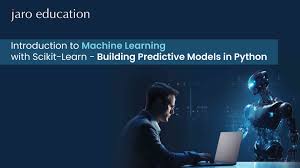Machine learning, a subset of artificial intelligence, is integral to modern technology, driving innovations in fields like healthcare, finance, and retail. Python, known for its simplicity and extensive libraries, has emerged as a leading language for implementing machine learning algorithms. Scikit-Learn, a powerful Python library, provides efficient tools for data mining and data analysis, making it an excellent choice for both beginners and experts. This article introduces machine learning with Python and Scikit-Learn, guiding you through the essentials to get started.
Why Python for Machine Learning?
Python’s readability and simplicity make it an ideal choice for beginners and experts alike. Its extensive libraries and frameworks, such as NumPy, Pandas, Matplotlib, and Scikit-Learn, offer robust tools for data manipulation, visualization, and algorithm implementation. Moreover, Python’s active community ensures a wealth of resources, including tutorials and forums, which can help you overcome any obstacles you might encounter.
A Python tutorial can be a great starting point for those new to the language. It covers the basics of Python programming, including syntax, data types, and control structures, laying a strong foundation for diving into more complex topics like machine learning.
Getting Started with Scikit-Learn
Scikit-Learn is an open-source library that simplifies the implementation of machine learning algorithms. It provides a consistent interface for various learning algorithms and is designed to work seamlessly with other Python libraries like NumPy and Pandas. To begin, you need to install Scikit-Learn along with other essential libraries, typically using an online Python compiler and Python distribution such as Anaconda, which simplifies package management and deployment.
Understanding the Basics
Machine learning can be broadly categorized into supervised learning, unsupervised learning, and reinforcement learning. Scikit-Learn focuses mainly on supervised and unsupervised learning.
– Supervised Learning: This involves training a model on a labeled dataset, where each training example is paired with an output label. Examples include classification and regression tasks.
– Unsupervised Learning: This involves training a model on data without labeled responses, typically used for clustering and association tasks.
Implementing a Simple Machine Learning Model
A typical workflow for implementing a machine learning model with Scikit-Learn includes loading data, preprocessing it, training a model, and evaluating its performance. For instance, using the popular Iris dataset, one can build and evaluate a model by following these steps:
1. Import Libraries: Start by importing the necessary libraries for data handling, model training, and evaluation.
2. Load and Split the Data: Load the dataset and split it into training and testing sets to evaluate the model’s performance on unseen data.
3. Preprocess the Data: Standardize or normalize the data to improve the model’s performance.
4. Train the Model: Use an appropriate machine learning algorithm to train the model on the training data.
5. Evaluate the Model: Assess the model’s performance using metrics like accuracy, precision, recall, and F1 score.
A detailed Data Science tutorial can provide further insights into selecting and tuning algorithms, handling different types of data, and improving model performance.
The Importance of Continuous Learning
Machine learning is a rapidly evolving field. Staying updated with the latest developments and continuously improving your skills is crucial. Online courses, tutorials, and community forums can be excellent resources. Engaging in hands-on projects and contributing to open-source projects can also enhance your understanding and expertise.
A comprehensive Python tutorial can deepen your understanding of the language, which is essential for writing efficient and effective machine learning code. Additionally, exploring an advanced AI tutorial can introduce you to more complex concepts and techniques, preparing you for real-world applications.
Conclusion
Machine learning with Python and Scikit-Learn opens up a world of possibilities for analyzing data and making intelligent predictions. Python’s ease of use and the extensive capabilities of Scikit-Learn make them a powerful combination for both beginners and experienced developers. By following a structured learning path that includes Python for data science tutorials, using a Python compiler, and exploring detailed AI tutorials, you can build a strong foundation in machine learning and stay at the forefront of technological innovation. As you continue to learn and experiment, you’ll be well-equipped to tackle increasingly complex challenges and contribute to the ever-growing field of artificial intelligence.

